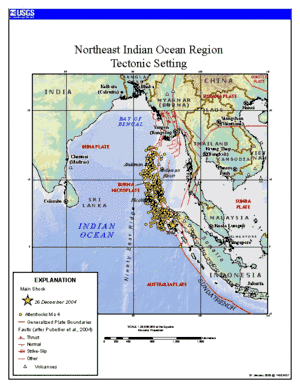Sunda Arc
The Sunda Arc is a volcanic arc that produced the islands of Sumatra and Java, the Sunda Strait and the Lesser Sunda Islands. A chain of volcanoes forms the topographic spine of these islands.

The Sunda Arc marks an active convergent boundary between the East Eurasian plates that underlie Indonesia, especially the Sunda Plate and the Burma Plate, with the India and Australian Plates that form the seabed of the Indian Ocean and the Bay of Bengal. The Sunda Arc is a classic example of a volcanic island arc, in which all the elements of such geodynamic features can be identified.
The India and Australian Plates are subducting beneath the Sunda and Burma plates along the Sunda Arc. The tectonic deformation along this subduction zone in the Java Trench (also known as the Sunda Trench) caused the 2004 Indian Ocean earthquake of 26 December, 2004.
Historic eruptions
The Sunda Arc is home to some of the world's most dangerous and explosive volcanoes. The 1815 eruption of Mount Tambora on Sumbawa and the 1257 eruption of Mount Samalas on Lombok were among the largest in the last two millennia, ranking 7 on the VEI scale. The Sunda Arc subduction zone was also the site of one of the largest known eruptions of the Cenozoic, the VEI 8 Toba supereruption on Sumatra, which expelled 2,800 km³ of magma c. 74,000 BP. The resulting caldera has become Lake Toba. The loudest noise in recorded history occurred during the 1883 eruption of Krakatoa and was heard 5,000 km (3,100 mi) away. Hundreds of thousands of people have been killed by these eruptions and by episodes of activity at other volcanoes, including Papandayan, Galunggung, Merapi, Kelud, and Agung.
Notable active volcanoes
While there are 35 and 45 active volcanoes on Sumatra and Java respectively, and ~30 in the Lesser Sunda Islands, a few are notable for their recent and/or ongoing activity.
- Mount Sinabung is a stratovolcano of andesite and dacite in the Karo plateau of North Sumatra, 40 kilometres (25 mi) from the Lake Toba supervolcano. It has been continuously active since 2013.
- Krakatoa: The island of Anak Krakatau has grown at an average rate of five inches (13 cm) per week since the 1950s. Quiet periods of a few days have alternated with almost continuous Strombolian eruptions since 1994.
- Mount Merapi is the most active volcano in Indonesia and has erupted regularly since 1548. The most recent significant eruptions occurred in 1994, 2006, and 2010.
Further reading
- Newcomb KR & McCann WR. (1987). Seismic history and seismotectonics of the Sunda Arc. Journal of Geophysical Research; 92:421–439.